Abstract
Upper airway dilator muscles play an important role in the pathophysiology of sleep apnea hypopnea syndrome (SAHS). The mechanical and structural characteristics of these muscles remain unknown. The aim of this study was to compare the physiologic, metabolic, and fiber type characteristics of one upper airway dilator muscle (musculus uvulae, MU) in 11 SAHS and in seven nonapneic snorers. The different analyses were done on MU obtained during uvulo-palato-pharyngoplasty. Snorers and SAHS differed only in their apnea + hypopnea indices (11.5 +/- 5.9 and 34.2 +/- 14.6/h, respectively, mean +/- SD). Absolute twitch and tetanic tension production of MU was significantly greater in SAHS than in snorers while the fatigability index was similar in the two groups. Protein content and anaerobic enzyme activities of MU were significantly greater in SAHS than in snorers; no difference was observed for aerobic enzyme activities. The total muscle fiber cross-sectional area of MU was significantly higher in SAHS (2.2 +/- 0.9 mm2) than in snorers (1.1 +/- 0.7 mm2). The surface occupied by type IIA muscle fibers of MU was larger in SAHS (2.00 +/- 0.96) than in snorers (0.84 +/- 0.63 mm2). We conclude that the capacity for tension production and the anaerobic metabolic activity of MU are greater in SAHS than in snorers.
Full text
PDF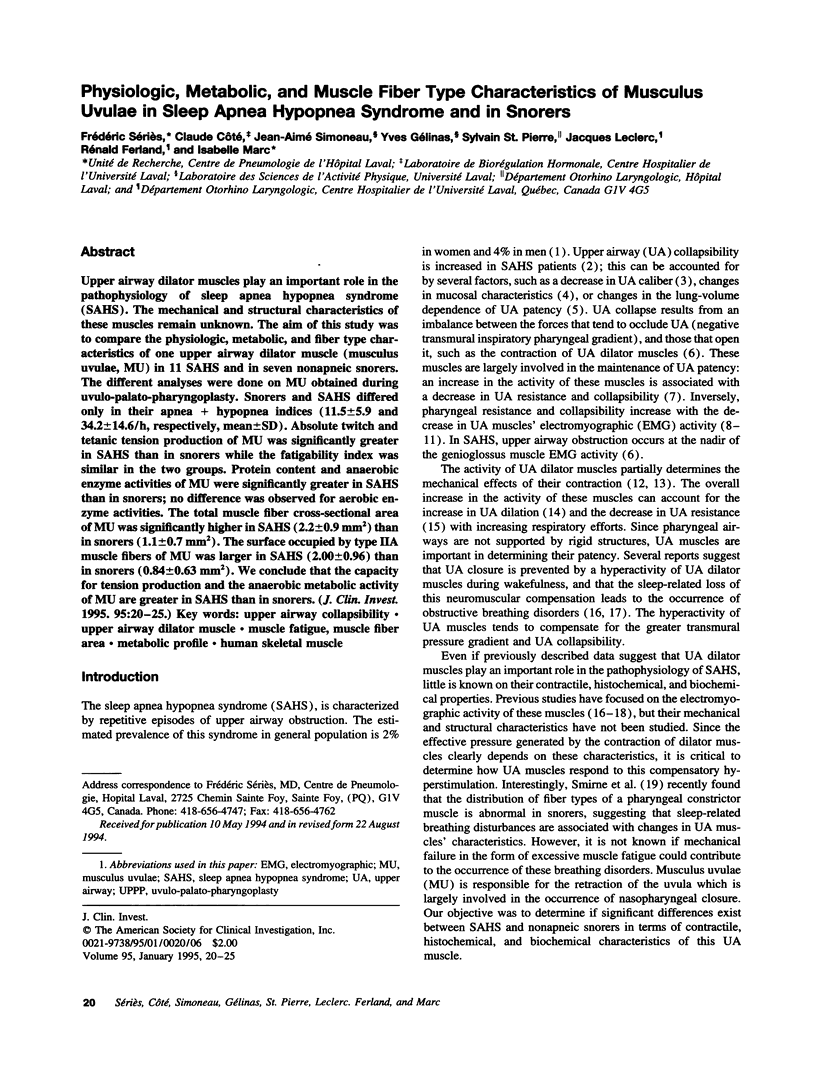
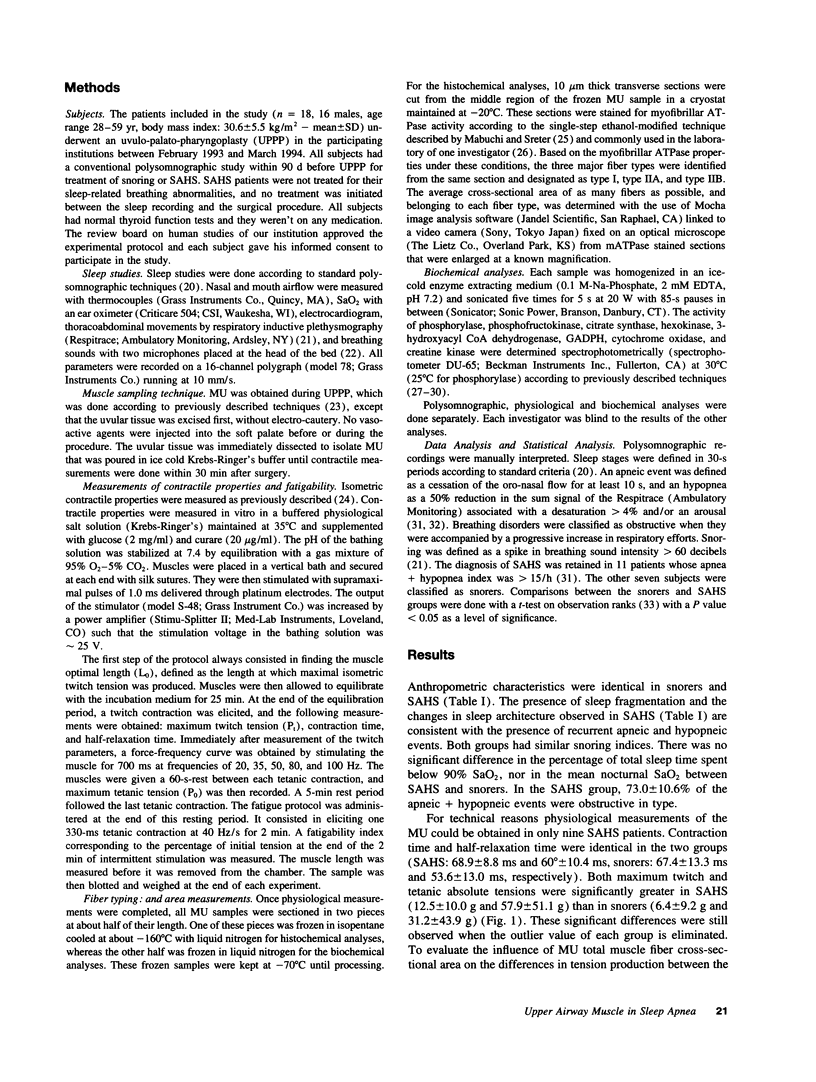
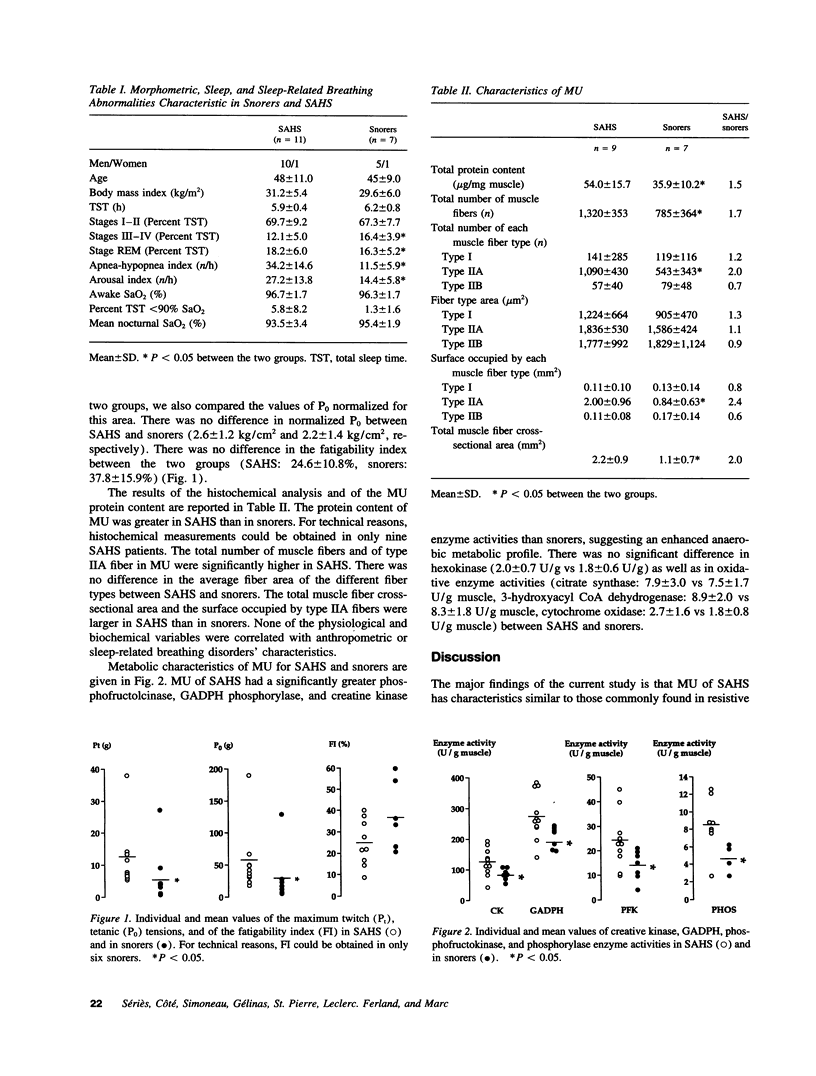
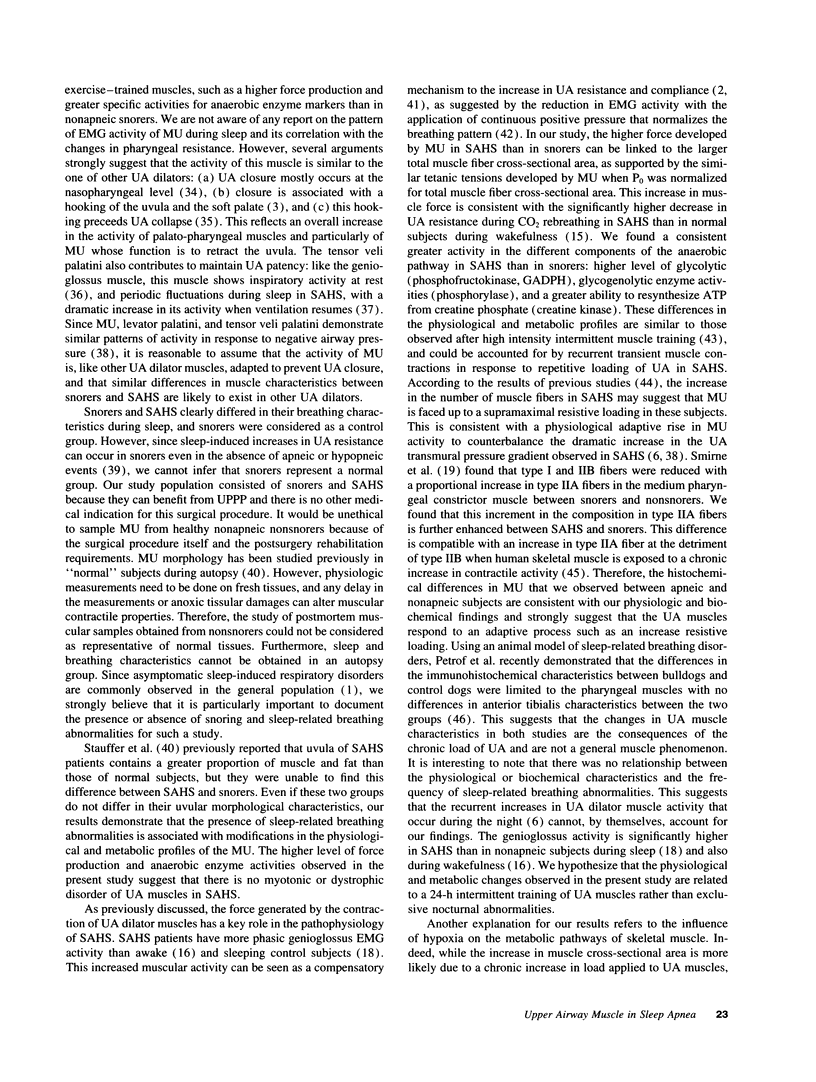
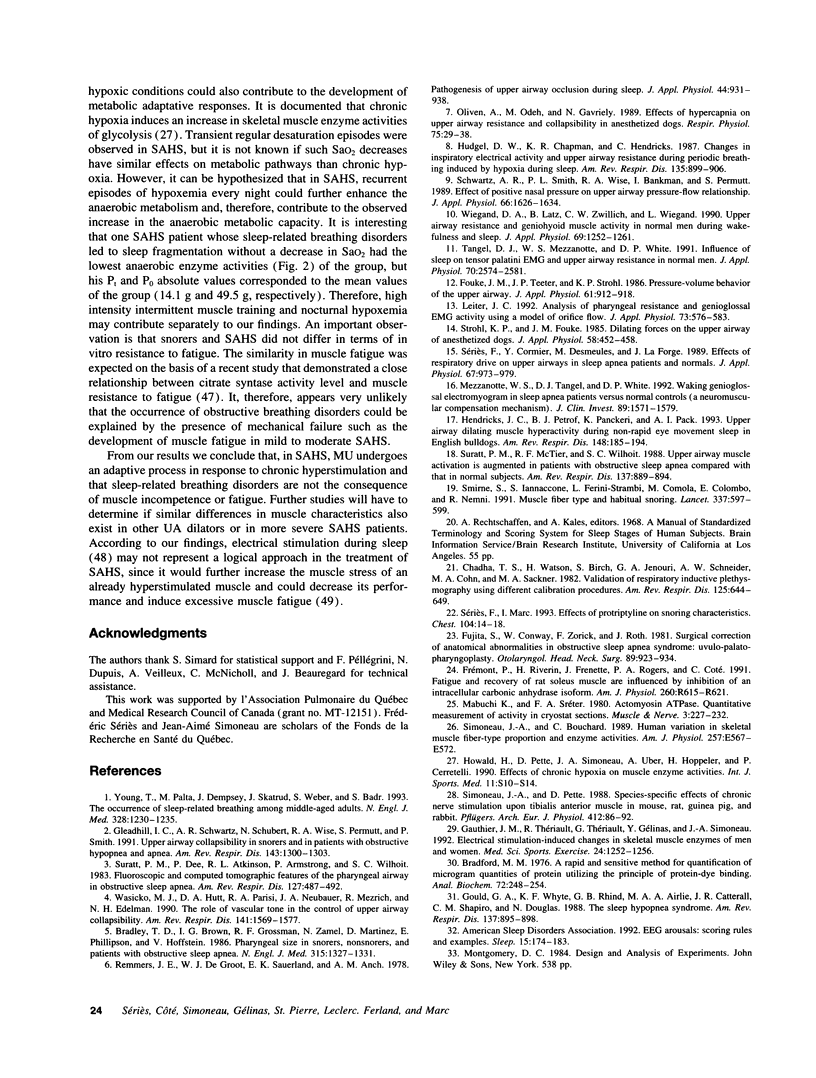
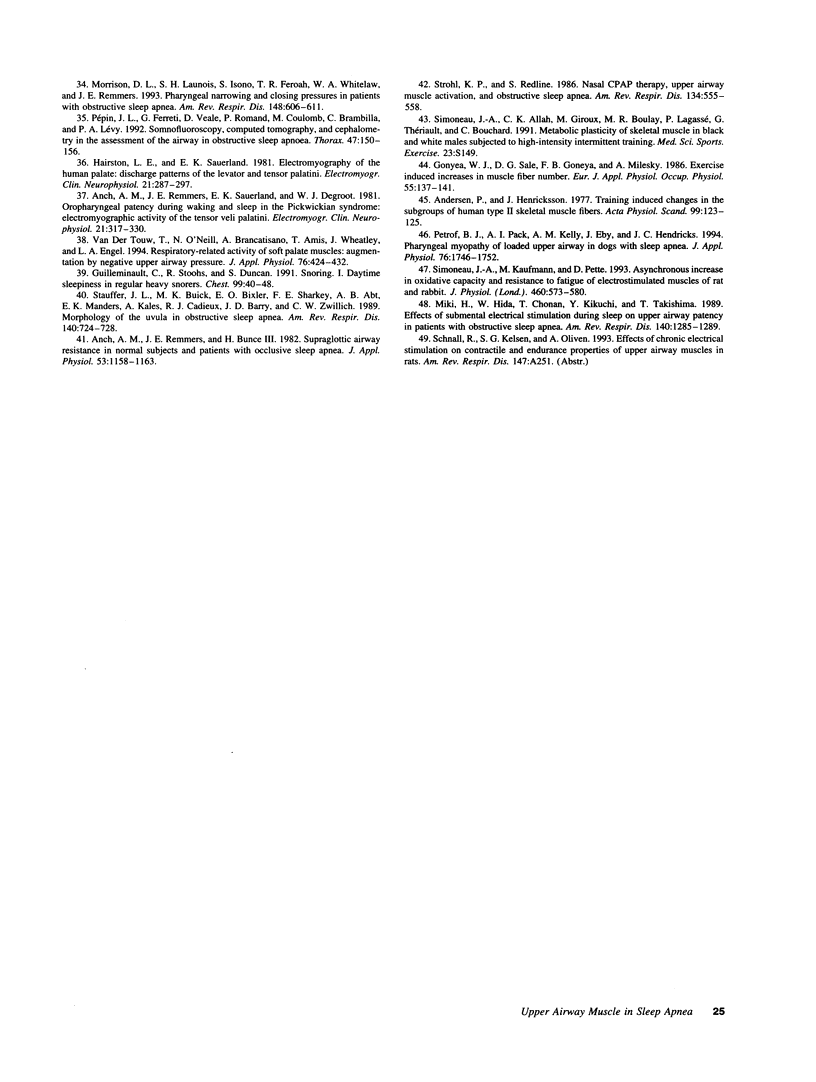
Selected References
These references are in PubMed. This may not be the complete list of references from this article.
- Anch A. M., Remmers J. E., Bunce H., 3rd Supraglottic airway resistance in normal subjects and patients with occlusive sleep apnea. J Appl Physiol Respir Environ Exerc Physiol. 1982 Nov;53(5):1158–1163. doi: 10.1152/jappl.1982.53.5.1158. [DOI] [PubMed] [Google Scholar]
- Anch A. M., Remmers J. E., Sauerland E. K., Degroot W. J. Oropharyngeal patency during walking and sleep in the Pickwickian syndrome: electromyographic activity of the tensor veli palatini. Electromyogr Clin Neurophysiol. 1981 Feb-Mar;21(2-3):317–330. [PubMed] [Google Scholar]
- Andersen P., Henriksson J. Training induced changes in the subgroups of human type II skeletal muscle fibres. Acta Physiol Scand. 1977 Jan;99(1):123–125. doi: 10.1111/j.1748-1716.1977.tb10361.x. [DOI] [PubMed] [Google Scholar]
- Bradford M. M. A rapid and sensitive method for the quantitation of microgram quantities of protein utilizing the principle of protein-dye binding. Anal Biochem. 1976 May 7;72:248–254. doi: 10.1016/0003-2697(76)90527-3. [DOI] [PubMed] [Google Scholar]
- Bradley T. D., Brown I. G., Grossman R. F., Zamel N., Martinez D., Phillipson E. A., Hoffstein V. Pharyngeal size in snorers, nonsnorers, and patients with obstructive sleep apnea. N Engl J Med. 1986 Nov 20;315(21):1327–1331. doi: 10.1056/NEJM198611203152105. [DOI] [PubMed] [Google Scholar]
- Chadha T. S., Watson H., Birch S., Jenouri G. A., Schneider A. W., Cohn M. A., Sackner M. A. Validation of respiratory inductive plethysmography using different calibration procedures. Am Rev Respir Dis. 1982 Jun;125(6):644–649. doi: 10.1164/arrd.1982.125.6.644. [DOI] [PubMed] [Google Scholar]
- Fouke J. M., Teeter J. P., Strohl K. P. Pressure-volume behavior of the upper airway. J Appl Physiol (1985) 1986 Sep;61(3):912–918. doi: 10.1152/jappl.1986.61.3.912. [DOI] [PubMed] [Google Scholar]
- Frémont P., Riverin H., Frenette J., Rogers P. A., Côté C. Fatigue and recovery of rat soleus muscle are influenced by inhibition of an intracellular carbonic anhydrase isoform. Am J Physiol. 1991 Mar;260(3 Pt 2):R615–R621. doi: 10.1152/ajpregu.1991.260.3.R615. [DOI] [PubMed] [Google Scholar]
- Fujita S., Conway W., Zorick F., Roth T. Surgical correction of anatomic azbnormalities in obstructive sleep apnea syndrome: uvulopalatopharyngoplasty. Otolaryngol Head Neck Surg. 1981 Nov-Dec;89(6):923–934. doi: 10.1177/019459988108900609. [DOI] [PubMed] [Google Scholar]
- Gauthier J. M., Thériault R., Thériault G., Gélinas Y., Simoneau J. A. Electrical stimulation-induced changes in skeletal muscle enzymes of men and women. Med Sci Sports Exerc. 1992 Nov;24(11):1252–1256. [PubMed] [Google Scholar]
- Gleadhill I. C., Schwartz A. R., Schubert N., Wise R. A., Permutt S., Smith P. L. Upper airway collapsibility in snorers and in patients with obstructive hypopnea and apnea. Am Rev Respir Dis. 1991 Jun;143(6):1300–1303. doi: 10.1164/ajrccm/143.6.1300. [DOI] [PubMed] [Google Scholar]
- Gonyea W. J., Sale D. G., Gonyea F. B., Mikesky A. Exercise induced increases in muscle fiber number. Eur J Appl Physiol Occup Physiol. 1986;55(2):137–141. doi: 10.1007/BF00714995. [DOI] [PubMed] [Google Scholar]
- Gould G. A., Whyte K. F., Rhind G. B., Airlie M. A., Catterall J. R., Shapiro C. M., Douglas N. J. The sleep hypopnea syndrome. Am Rev Respir Dis. 1988 Apr;137(4):895–898. doi: 10.1164/ajrccm/137.4.895. [DOI] [PubMed] [Google Scholar]
- Guilleminault C., Stoohs R., Duncan S. Snoring (I). Daytime sleepiness in regular heavy snorers. Chest. 1991 Jan;99(1):40–48. doi: 10.1378/chest.99.1.40. [DOI] [PubMed] [Google Scholar]
- Hairston L. E., Sauerland E. K. Electromyography of the human palate: discharge patterns of the levator and tensor veli palatini. Electromyogr Clin Neurophysiol. 1981 Feb-Mar;21(2-3):287–297. [PubMed] [Google Scholar]
- Hendricks J. C., Petrof B. J., Panckeri K., Pack A. I. Upper airway dilating muscle hyperactivity during non-rapid eye movement sleep in English bulldogs. Am Rev Respir Dis. 1993 Jul;148(1):185–194. doi: 10.1164/ajrccm/148.1.185. [DOI] [PubMed] [Google Scholar]
- Howald H., Pette D., Simoneau J. A., Uber A., Hoppeler H., Cerretelli P. Effect of chronic hypoxia on muscle enzyme activities. Int J Sports Med. 1990 Feb;11 (Suppl 1):S10–S14. doi: 10.1055/s-2007-1024847. [DOI] [PubMed] [Google Scholar]
- Hudgel D. W., Chapman K. R., Faulks C., Hendricks C. Changes in inspiratory muscle electrical activity and upper airway resistance during periodic breathing induced by hypoxia during sleep. Am Rev Respir Dis. 1987 Apr;135(4):899–906. doi: 10.1164/arrd.1987.135.4.899. [DOI] [PubMed] [Google Scholar]
- Leiter J. C. Analysis of pharyngeal resistance and genioglossal EMG activity using a model of orifice flow. J Appl Physiol (1985) 1992 Aug;73(2):576–583. doi: 10.1152/jappl.1992.73.2.576. [DOI] [PubMed] [Google Scholar]
- Mabuchi K., Sréter F. A. Actomyosin ATPase. I. Quantitative measurement of activity in cryostat sections. Muscle Nerve. 1980 May-Jun;3(3):227–232. doi: 10.1002/mus.880030307. [DOI] [PubMed] [Google Scholar]
- Mezzanotte W. S., Tangel D. J., White D. P. Waking genioglossal electromyogram in sleep apnea patients versus normal controls (a neuromuscular compensatory mechanism). J Clin Invest. 1992 May;89(5):1571–1579. doi: 10.1172/JCI115751. [DOI] [PMC free article] [PubMed] [Google Scholar]
- Miki H., Hida W., Chonan T., Kikuchi Y., Takishima T. Effects of submental electrical stimulation during sleep on upper airway patency in patients with obstructive sleep apnea. Am Rev Respir Dis. 1989 Nov;140(5):1285–1289. doi: 10.1164/ajrccm/140.5.1285. [DOI] [PubMed] [Google Scholar]
- Morrison D. L., Launois S. H., Isono S., Feroah T. R., Whitelaw W. A., Remmers J. E. Pharyngeal narrowing and closing pressures in patients with obstructive sleep apnea. Am Rev Respir Dis. 1993 Sep;148(3):606–611. doi: 10.1164/ajrccm/148.3.606. [DOI] [PubMed] [Google Scholar]
- Oliven A., Odeh M., Gavriely N. Effect of hypercapnia on upper airway resistance and collapsibility in anesthetized dogs. Respir Physiol. 1989 Jan;75(1):29–38. doi: 10.1016/0034-5687(89)90084-4. [DOI] [PubMed] [Google Scholar]
- Pepin J. L., Ferretti G., Veale D., Romand P., Coulomb M., Brambilla C., Lévy P. A. Somnofluoroscopy, computed tomography, and cephalometry in the assessment of the airway in obstructive sleep apnoea. Thorax. 1992 Mar;47(3):150–156. doi: 10.1136/thx.47.3.150. [DOI] [PMC free article] [PubMed] [Google Scholar]
- Petrof B. J., Pack A. I., Kelly A. M., Eby J., Hendricks J. C. Pharyngeal myopathy of loaded upper airway in dogs with sleep apnea. J Appl Physiol (1985) 1994 Apr;76(4):1746–1752. doi: 10.1152/jappl.1994.76.4.1746. [DOI] [PubMed] [Google Scholar]
- Remmers J. E., deGroot W. J., Sauerland E. K., Anch A. M. Pathogenesis of upper airway occlusion during sleep. J Appl Physiol Respir Environ Exerc Physiol. 1978 Jun;44(6):931–938. doi: 10.1152/jappl.1978.44.6.931. [DOI] [PubMed] [Google Scholar]
- Schwartz A. R., Smith P. L., Wise R. A., Bankman I., Permutt S. Effect of positive nasal pressure on upper airway pressure-flow relationships. J Appl Physiol (1985) 1989 Apr;66(4):1626–1634. doi: 10.1152/jappl.1989.66.4.1626. [DOI] [PubMed] [Google Scholar]
- Simoneau J. A., Bouchard C. Human variation in skeletal muscle fiber-type proportion and enzyme activities. Am J Physiol. 1989 Oct;257(4 Pt 1):E567–E572. doi: 10.1152/ajpendo.1989.257.4.E567. [DOI] [PubMed] [Google Scholar]
- Simoneau J. A., Kaufmann M., Pette D. Asynchronous increases in oxidative capacity and resistance to fatigue of electrostimulated muscles of rat and rabbit. J Physiol. 1993 Jan;460:573–580. doi: 10.1113/jphysiol.1993.sp019487. [DOI] [PMC free article] [PubMed] [Google Scholar]
- Simoneau J. A., Pette D. Species-specific effects of chronic nerve stimulation upon tibialis anterior muscle in mouse, rat, guinea pig, and rabbit. Pflugers Arch. 1988 Jul;412(1-2):86–92. doi: 10.1007/BF00583735. [DOI] [PubMed] [Google Scholar]
- Smirne S., Iannaccone S., Ferini-Strambi L., Comola M., Colombo E., Nemni R. Muscle fibre type and habitual snoring. Lancet. 1991 Mar 9;337(8741):597–599. doi: 10.1016/0140-6736(91)91651-a. [DOI] [PubMed] [Google Scholar]
- Stauffer J. L., Buick M. K., Bixler E. O., Sharkey F. E., Abt A. B., Manders E. K., Kales A., Cadieux R. J., Barry J. D., Zwillich C. W. Morphology of the uvula in obstructive sleep apnea. Am Rev Respir Dis. 1989 Sep;140(3):724–728. doi: 10.1164/ajrccm/140.3.724. [DOI] [PubMed] [Google Scholar]
- Strohl K. P., Fouke J. M. Dilating forces on the upper airway of anesthetized dogs. J Appl Physiol (1985) 1985 Feb;58(2):452–458. doi: 10.1152/jappl.1985.58.2.452. [DOI] [PubMed] [Google Scholar]
- Strohl K. P., Redline S. Nasal CPAP therapy, upper airway muscle activation, and obstructive sleep apnea. Am Rev Respir Dis. 1986 Sep;134(3):555–558. doi: 10.1164/arrd.1986.134.3.555. [DOI] [PubMed] [Google Scholar]
- Suratt P. M., Dee P., Atkinson R. L., Armstrong P., Wilhoit S. C. Fluoroscopic and computed tomographic features of the pharyngeal airway in obstructive sleep apnea. Am Rev Respir Dis. 1983 Apr;127(4):487–492. doi: 10.1164/arrd.1983.127.4.487. [DOI] [PubMed] [Google Scholar]
- Suratt P. M., McTier R. F., Wilhoit S. C. Upper airway muscle activation is augmented in patients with obstructive sleep apnea compared with that in normal subjects. Am Rev Respir Dis. 1988 Apr;137(4):889–894. doi: 10.1164/ajrccm/137.4.889. [DOI] [PubMed] [Google Scholar]
- Sériès F., Cormier Y., Desmeules M., La Forge J. Effects of respiratory drive on upper airways in sleep apnea patients and normal subjects. J Appl Physiol (1985) 1989 Sep;67(3):973–979. doi: 10.1152/jappl.1989.67.3.973. [DOI] [PubMed] [Google Scholar]
- Sériès F., Marc I. Effects of protriptyline on snoring characteristics. Chest. 1993 Jul;104(1):14–18. doi: 10.1378/chest.104.1.14. [DOI] [PubMed] [Google Scholar]
- Tangel D. J., Mezzanotte W. S., White D. P. Influence of sleep on tensor palatini EMG and upper airway resistance in normal men. J Appl Physiol (1985) 1991 Jun;70(6):2574–2581. doi: 10.1152/jappl.1991.70.6.2574. [DOI] [PubMed] [Google Scholar]
- Van der Touw T., O'Neill N., Brancatisano A., Amis T., Wheatley J., Engel L. A. Respiratory-related activity of soft palate muscles: augmentation by negative upper airway pressure. J Appl Physiol (1985) 1994 Jan;76(1):424–432. doi: 10.1152/jappl.1994.76.1.424. [DOI] [PubMed] [Google Scholar]
- Wasicko M. J., Hutt D. A., Parisi R. A., Neubauer J. A., Mezrich R., Edelman N. H. The role of vascular tone in the control of upper airway collapsibility. Am Rev Respir Dis. 1990 Jun;141(6):1569–1577. doi: 10.1164/ajrccm/141.6.1569. [DOI] [PubMed] [Google Scholar]
- Wiegand D. A., Latz B., Zwillich C. W., Wiegand L. Upper airway resistance and geniohyoid muscle activity in normal men during wakefulness and sleep. J Appl Physiol (1985) 1990 Oct;69(4):1252–1261. doi: 10.1152/jappl.1990.69.4.1252. [DOI] [PubMed] [Google Scholar]
- Young T., Palta M., Dempsey J., Skatrud J., Weber S., Badr S. The occurrence of sleep-disordered breathing among middle-aged adults. N Engl J Med. 1993 Apr 29;328(17):1230–1235. doi: 10.1056/NEJM199304293281704. [DOI] [PubMed] [Google Scholar]


